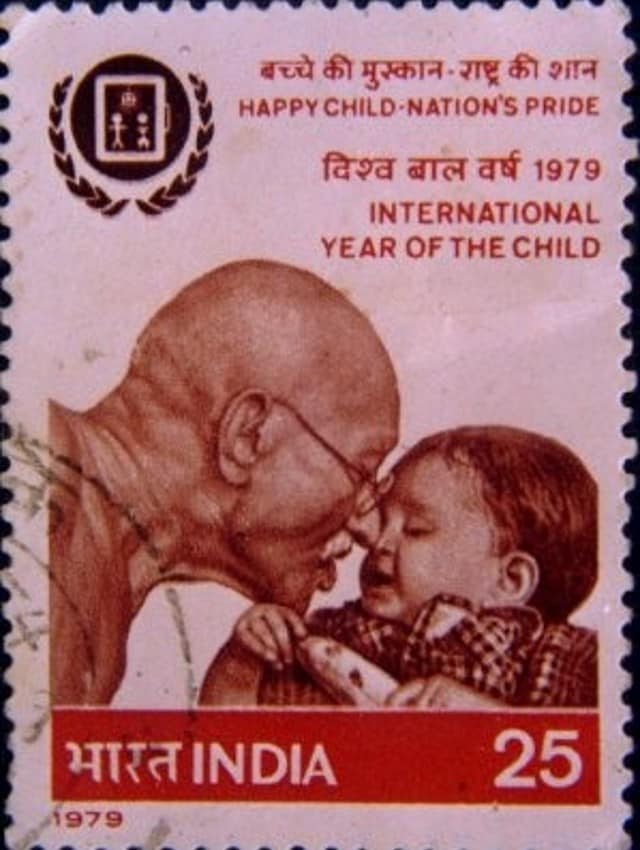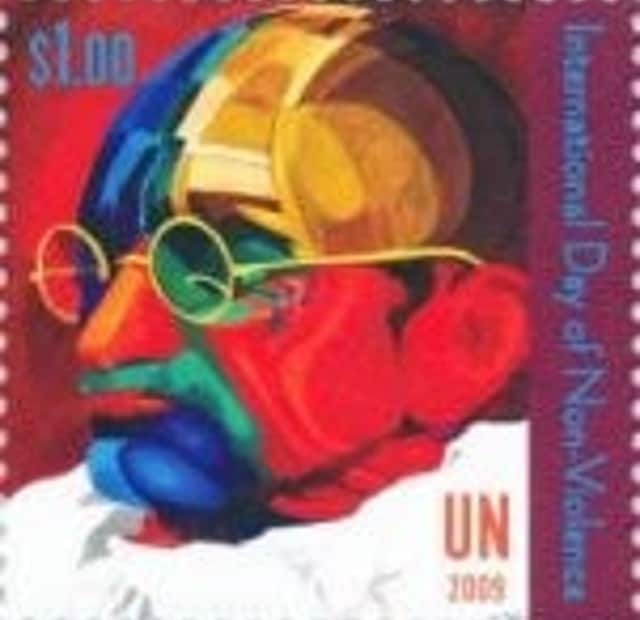A commemorative stamp is something of a cultural landmark. It honours an individual (or an event) as being one of significant influence. When a nation honours one of its own with a stamp, it is a huge recognition. When other nations do so, it is even more significant and an indication that the person is nothing less than a bona fide celebrity. Mahatma Gandhi has featured on the postage stamps of hundred-plus countries. What does that make him? A universal celebrity? A person of influence with few parallels? When did it all begin, though—this business of featuring people on stamps and specifically, Gandhi on stamps in particular? The beginning Come to think of it, the world’s first stamp was a celebrity stamp. In 1837, when postal rates were a complicated matter in Britain, Rowland Hill proposed the idea of an adhesive stamp to standardize rates. In May 1840, the first such stamp went on sale. This stamp bore a profile of Queen Victoria! Known popularly as the Penny Black (a clear reference to its cost and colour), this stamp is widely considered the world’s first widely used postage stamp. The British monarch then became a ubiquitous presence on the stamp, a practice that continues to the present day.
The Gandhi stamp trail in India In India, Gandhi debuted on a postage stamp on 15 August 1948. Four stamps were issued of 1½ anna, 3½ annas, 12 annas and Rs 10 denominations by the Indian government. The plan to issue these stamps had been set in motion in January 1948, when Gandhi was still alive and the Security Press in Nasik was chosen to print them. His assassination that same month forced the plan to be altered a little bit. It was decided to print these stamps as a memorial and instead of Nasik, they were printed at the Swiss printers, Helio Courvoisier, Sa. LaChaux De Fonds. When the then Governor-General of India, C Rajagopalachari, wished to use the Gandhi stamps for his official needs, the word ‘Service’ (short for ‘On India Government Service’) was overprinted on these stamps to distinguish them from the regular issue. Today, this Gandhi ‘Service’ stamp is among the world’s rarest stamps. Only 100 stamps (two sheets of 50) were brought out. In October 2007, one ‘Service’ set was auctioned for €38,000. In 2011 David Feldman sold a single stamp for a price of €144,000 ($ 205,000)—the highest price ever paid for a single Indian stamp. It is believed that only 18 of these stamps still exist. A 2006 book by Dr. Reuben Ramkissoon and Dr. Rajagopalan entitled A Philatelic Handbook on Mohandas Karamchand Gandhi (Mahatma Gandhi) states that less than 8 copies of these stamps are in private hands. Much about these stamps is ironic and at least one detail is incorrect. That these stamps were printed abroad is perhaps the most ironic detail, given that Gandhi batted for Swadeshi all his life. Then there is the decision to only depict him above the waist since bureaucrats opined that showing him in full length with only his dhoti and shawl wasn’t ‘dignified’ enough. Given the political overtones of Gandhi’s sartorial choices, this was more than ironic. And to top it all, the artistic rendition didn’t correctly capture the way Gandhi draped himself. One could even question the decision to issue a Gandhi stamp itself when Gandhi himself preferred to scrawl on postcards.
For reasons unclear, the stamps were withdrawn from sale in January 1949. Their usage was not outlawed though and many stamps remained in use for a long time thereafter. From April 1957, India opted for the decimal system in its coinage and currency, with paise and rupees becoming the nomenclature. The old ‘Annas’ system was discontinued. The 1½ anna and 3½ annas Gandhi Stamps were also demonetized on 1st October 1959, but the 12 Annas and Rs. 10 Gandhi stamps were still valid and could be used. Going global On 26 January 1961, the USA became the first foreign country to issue a Gandhi stamp. The Congo followed in 1967.
In 1969, Gandhi’s centenary year, about 40 countries released Gandhi stamps. Among the countries that honoured Gandhi that year were Bhutan, Brazil, Czechoslovakia, Egypt, Germany (West), Guyana, Hungry, Mexico, Poland, Russia (USSR), Somalia, Suriname and … the UK! Incidentally, Bhutan and Somalia had their stamps printed at Nasik. That the UK decided to release a stamp to Gandhi in his centenary year was both ironic and a case of things coming a full circle. Lord Mountbatten who had been requested by the Indian President to be the Chairman of the UK Gandhi Centenary Committee actually set the ball rolling for the erstwhile colonizer to issue a stamp. While there was resistance, given Moutbatten’s stature, the government conceded and went ahead. By 1969, the British ‘Empire’ was nothing but a historical detail. Virtually all of its colonies in Asia, Africa and the Caribbean had either become independent or attained self-rule. Think of this stamp then as a posthumous doffing of the hat to the man who had begun the process of decolonization. Of course, it is another matter that going by recent reports it is clear that Britain has never quite taught its people the ills of its colonization policies given that many Britons still seem to think that their ‘Empire’ was an instrument for good!
India, for its part issued a stamp honouring both Gandhi and Kasturba Gandhi for the centenary besides others.
Spoilt for choice The Kasturba stamp released in 1969 wasn’t the first one honouring Kasturba Gandhi released by the Indian government. In February 1964, a stamp had been released in her honour on her 20th death anniversary.
As for Gandhi, dozens of stamps have been released in India. Many of these stamps merely depict Gandhi. But there have been others released commemorating the Dandi March, the Quit India movement, the centenaries of the first Satyagraha, his return to India, the Champaran agitation and so on.
[caption id=“attachment_11371531” align=“alignnone” width=“640”] A stamp depicting Gandhi and Nehru was released in 1973.[/caption] [caption id=“attachment_11371581” align=“alignnone” width=“640”]
 In 1979, the International Year of the Child, a stamp was released depicting his love for children.[/caption] In 2000, an unusual stamp was released depicting Gandhi in caricature by the cartoonist, Ranga. The cartoon also referenced the map of India and played on the ‘Father of the Nation’ tag accorded to him.
In 1979, the International Year of the Child, a stamp was released depicting his love for children.[/caption] In 2000, an unusual stamp was released depicting Gandhi in caricature by the cartoonist, Ranga. The cartoon also referenced the map of India and played on the ‘Father of the Nation’ tag accorded to him.
In addition, there have been stamps featuring the charkha, both by itself and depicting Gandhi using it. The stamp with the charkha by itself also references Gandhi’s Quit India slogan – ‘Do or Die’ and was released in 1992, the 50th anniversary of the Quit India Movement.
[caption id=“attachment_11371681” align=“alignnone” width=“640”] In 2008, the Comoros islands issued a stamp of Gandhi with his nieces, Abha and Manu[/caption] [caption id=“attachment_11371701” align=“alignnone” width=“640”]
 In 2009, the United Nations issued a stamp when it declared 2 October as the International Day of Non-Violence[/caption] Perhaps the most unusual country to release a Gandhi stamp is North Korea. In October 2018, they issued a stamp on paper silk cloth designed by Chennai based philatelist, Ramesh Ethiraj.
In 2009, the United Nations issued a stamp when it declared 2 October as the International Day of Non-Violence[/caption] Perhaps the most unusual country to release a Gandhi stamp is North Korea. In October 2018, they issued a stamp on paper silk cloth designed by Chennai based philatelist, Ramesh Ethiraj.
150! In 2019, Gandhi’s 150th birth anniversary, several stamps commemorating the event were released the world over. Among the more interesting stamps released by the Indian government was the one depicting the ‘Three Monkeys’ which has become identified with Gandhi.
Malaysia released a Swarovski Crystal inlaid stamp on this occasion, surely one of the most unusual stamps ever released, both on Gandhi or even otherwise!
Portugal, on the other hand, released a khadi stamp that same year.
Azerbaijan, France, Mauritius, Monaco, Malta, Mongolia, Kyrgyzstan, USA and Uzbekistan were some of the other countries who also released stamps in 2019.
Come to think of it, why release a Gandhi stamp at all, especially in the case of a foreign nation? It is certainly a good PR exercise. A case in point is North Korea which actually got some positive coverage in the Indian media, when it released a Gandhi stamp. Then there is perhaps a certain idealism that informs the decision. In the case of former colonies, it is something of a tribute and a reaffirmation of values. In the case of others, it is probably a recognition of his legacy which is still hugely influential. Given all of this, the Gandhi stamp gallery is only going to grow and grow and grow!
Read all the Latest News , Trending News , Cricket News , Bollywood News , India News and Entertainment News here. Follow us on Facebook, Twitter and Instagram.


)

)
)
)
)
)
)
)
)



